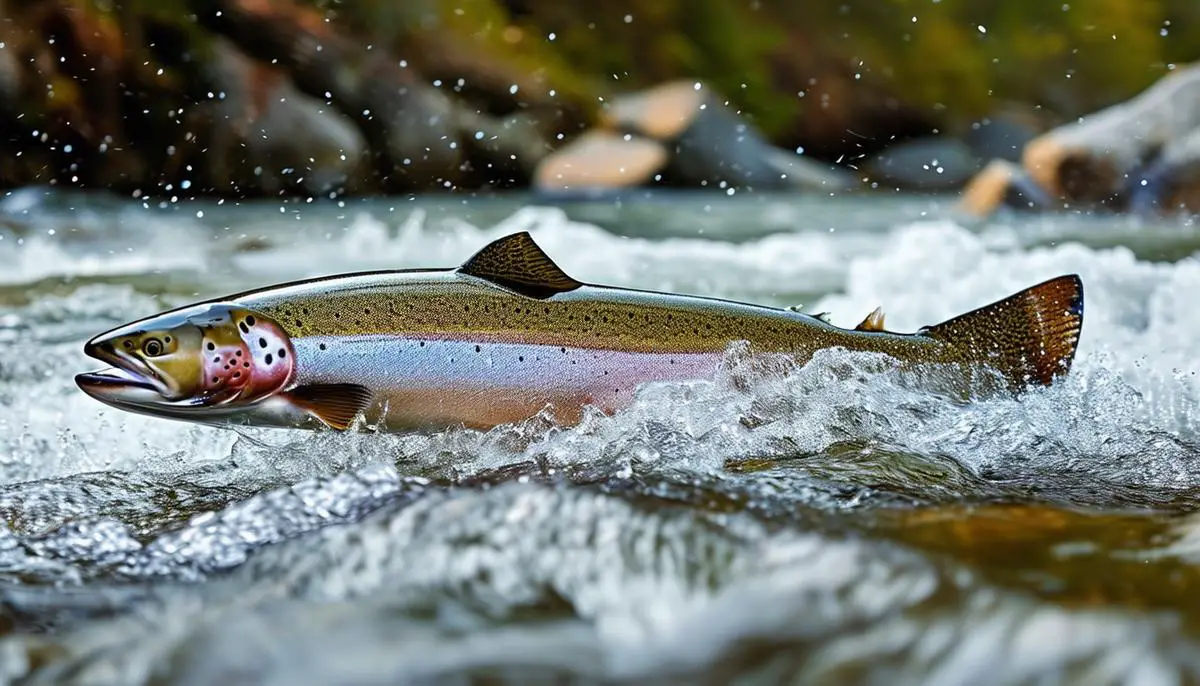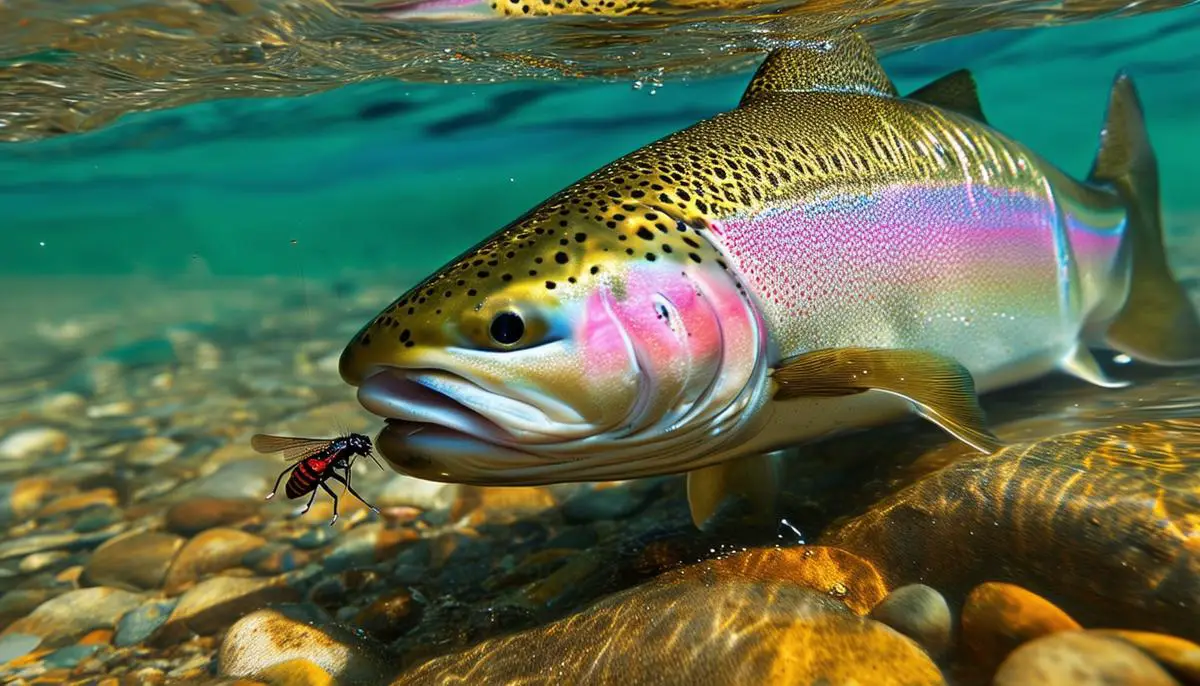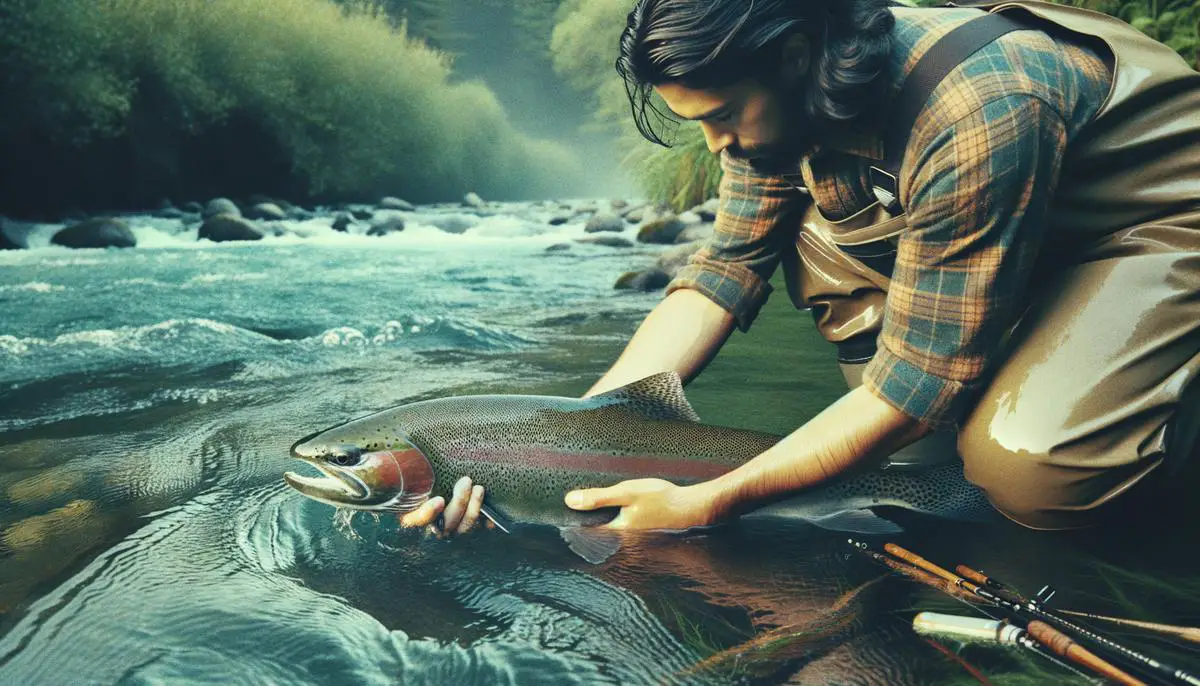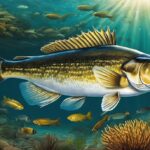Classification of Trout
Rainbow Trout and Steelhead, though sharing the scientific name Oncorhynchus mykiss, lead distinct lives shaped by their environmental choices. Rainbow Trout are freshwater residents, spending their entire lives in lakes, rivers, streams, and ponds. This consistent lifestyle influences their physical characteristics and behavior.
Steelhead, in contrast, are anadromous, born in freshwater but migrating to the ocean to mature before returning to freshwater to spawn. Their time in the nutrient-rich ocean allows them to grow larger, with some reaching an impressive 30 pounds.
Physical differences between the two are noticeable. Steelhead, more streamlined and torpedo-shaped, often have a more metallic or silvery hue from their ocean residence. However, upon re-entering freshwater, they display vibrant colors with a distinctive pink-red stripe, similar to Rainbow Trout.
In the Great Lakes region, classification debates arise over Rainbow Trout that exhibit Steelhead-like migration patterns while remaining in freshwater.
Both Rainbow Trout and Steelhead have diverse diets, consuming:
- Zooplankton
- Fish eggs
- Small fish
- Crustaceans
- Mollusks
- Insects
- Occasionally mice
This varied diet supports their growth and adaptability.
Adult Steelhead often outsize Rainbow Trout due to their oceanic phase. However, freshwater Rainbow Trout can still reach up to 45 inches and weigh over 50 pounds.
Habitat degradation, disease, and fishing pressures challenge the existence of both fish. Conservation efforts aim to preserve their environments and mitigate human impact to sustain their populations.1
Habitats and Life Cycles
Rainbow Trout inhabit freshwater environments, thriving in lakes, rivers, streams, and ponds. They utilize aquatic vegetation, boulders, and submerged wood for cover, influencing their vibrant colors and black spots.
Steelhead, born in freshwater, migrate to the ocean for a significant portion of their lives. This journey transforms them, resulting in larger, more streamlined physiques with a silvery or brassy sheen. Returning to freshwater to spawn, they undergo color changes, displaying hues similar to Rainbow Trout.
Freshwater ecosystems are vital for both species. Rainbow Trout find all necessary resources for growth and reproduction in these habitats. Steelhead leverage their oceanic phase for growth, returning to freshwater to propagate and ensure genetic diversity.
Steelhead exhibit dynamic seasonal behaviors, migrating back to natal streams to spawn multiple times throughout their lives. These migrations aid in the dissemination and mixing of genetic material across populations.
The interplay between habitat and life cycle dictates size, color, and physical form. Steelhead's ocean phase enables larger growth compared to Rainbow Trout, although both can reach impressive sizes in suitable environments.
Understanding the unique ecological needs of both species is crucial for effective conservation efforts, ensuring their continued thriving.2
Behavior and Migration Patterns
Steelhead exhibit remarkable migration behaviors, journeying from freshwater to the ocean and back. Born in rivers or creeks, young Steelhead, or "smolts," travel downstream to the ocean one to three years after hatching, adapting to the transition from freshwater to saltwater.
In the ocean, Steelhead capitalize on abundant food sources to grow rapidly, developing streamlined bodies and a silvery or brassy appearance. This oceanic phase lasts two to four years before they return to freshwater to spawn.
Rainbow Trout, being strictly freshwater residents, exhibit less migratory behavior. They establish territories within their habitats, with growth influenced by food availability and habitat quality.
The migratory journey significantly impacts Steelhead's size and appearance. Re-entering freshwater, they undergo a dramatic transformation, showcasing vibrant colors and a prominent pink or red stripe. This change attracts mates and signifies spawning readiness.
Rainbow Trout, though non-migratory, also display brilliant coloration, with a blue-green or yellowish body, silvery white underside, and a pink-red stripe. Their color patterns remain relatively consistent due to their stable freshwater environment.
Steelhead's adaptability to varied environmental conditions highlights the importance of preserving both freshwater and marine habitats. Maintaining barrier-free migratory routes and protecting spawning grounds are essential for sustaining healthy populations.
The contrasting behaviors of Steelhead and Rainbow Trout showcase their remarkable resilience and adaptations to their respective habitats, underscoring the need for targeted conservation efforts.

Regional Variations
The Great Lakes present an intriguing case of Rainbow Trout that migrate within a freshwater system, sparking debate over their classification as Steelhead.
These fish begin life in freshwater tributaries, then migrate to the open waters of the Great Lakes to grow and feed, mirroring the behavior of ocean-going Steelhead. They return to their natal streams to spawn, exhibiting similar growth patterns and physical attributes to traditional Steelhead.
However, the key difference lies in the environment. Great Lakes Rainbows remain in freshwater throughout their lives, not undergoing the physiological changes required for saltwater transition. The term "anadromous" technically does not apply to these fish, despite their migratory behaviors within a freshwater context.
Among anglers, opinions vary on whether the migratory behavior and size of these fish warrant a Steelhead classification. Some argue that their migration-based life cycle aligns them more closely with Steelhead, while others maintain that the absence of a saltwater phase precludes this classification.
This debate highlights the intricacy of fish classification, influenced by behavior, environment, and genetics. It also emphasizes the intricate relationships between species and their habitats, illustrating how environmental factors shape life cycles.
The classification of Great Lakes migrating Rainbows may ultimately depend on scientific consensus and regional fishing regulations. Regardless of their label, these fish represent nature's adaptability and the diverse ways life thrives in varying environments.
Understanding regional variations is essential for effective management and preservation efforts. Acknowledging the unique characteristics and behaviors of both Rainbow Trout and Steelhead in their respective environments fosters appreciation for these magnificent fish and informs conservation strategies for their sustainability.3

Diet and Feeding Habits
Understanding the dietary preferences of Rainbow Trout and Steelhead is crucial for appreciating their life cycles, growth patterns, and habitat adaptations. Both species display a remarkable ability to exploit diverse food resources available in their respective environments, which supports their health, growth, and reproductive success.
In their early life stages, both Rainbow Trout and Steelhead begin with a diet consisting primarily of zooplankton. As they mature, their dietary preferences expand to accommodate their growing bodies and energy needs. Juvenile Rainbow Trout and Steelhead transition to consuming a wider range of prey items, including:
- Insect larvae
- Small fish
- Fish eggs
This shift is particularly beneficial during periods when insects are less abundant.
Steelhead, during their ocean phase, exhibit an even more varied and opportunistic diet. The nutrient-rich marine environment allows them to feast on a wide array of prey, including crustaceans such as shrimp, krill, and crabs, as well as small fish, squid, and other marine organisms. The oceanic diet of Steelhead significantly contributes to their impressive size, often much larger than their freshwater-only Rainbow Trout counterparts.
In freshwater environments, adult Rainbow Trout maintain a versatile diet that includes aquatic and terrestrial insects, small fish, crustaceans, and even occasional amphibians. They are opportunistic feeders, adjusting their diet based on seasonal availability and environmental conditions. Interestingly, both Rainbow Trout and Steelhead may exhibit cannibalistic tendencies when food is scarce, with larger individuals preying on smaller or younger members of their own species1.
The dietary flexibility of Rainbow Trout and Steelhead highlights their adaptability and resilience in various habitats. Their ability to efficiently utilize a wide range of food sources enables them to thrive in both relatively stable freshwater environments and more dynamic, nutrient-rich oceanic territories. This adaptability supports their impressive growth and reproductive success, emphasizing the importance of conserving the varied habitats these remarkable fish call home.

Conservation Status and Threats
The conservation status of Rainbow Trout and Steelhead reflects both the resilience and vulnerability of these iconic fish species. While Rainbow Trout are generally abundant due to their widespread introduction, native populations still face significant challenges. Steelhead, with their complex life cycle involving both freshwater and saltwater phases, have proven to be more vulnerable, with some populations facing extinction.
Habitat degradation poses a primary threat to both species. Urban development, agriculture, and deforestation have led to the destruction and fragmentation of critical freshwater habitats. Stream modification, such as dam construction, disrupts normal water flow and temperature, severely impacting spawning grounds and migration routes. Dams obstruct the migratory paths of Steelhead, preventing access to vital spawning areas upstream.
Disease, particularly whirling disease caused by a parasitic infection, poses another significant threat to native Rainbow Trout populations. This disease can devastate hatcheries and wild populations alike. Overfishing has historically been a significant issue for Steelhead, with both commercial and recreational fishing pressures depleting many populations.
Conservation programs are making strides in addressing these challenges. Legal protections, such as the Endangered Species Act (ESA) in the United States, provide frameworks for protecting vulnerable populations. Habitat restoration projects, including dam removal and river flow restoration, aim to improve connectivity and rejuvenate degraded ecosystems. Hatcheries play a dual role in supporting population numbers and fostering genetic diversity, while strict fishing regulations help manage and conserve fish populations.
Community engagement and education are key elements of conservation strategies. Anglers and local communities are often involved in citizen science projects, contributing to data collection and monitoring efforts. Environmental organizations and government agencies collaborate on large-scale habitat restoration projects to create healthier environments that support the diverse life stages of Rainbow Trout and Steelhead.
While Rainbow Trout and Steelhead face numerous threats, concerted conservation efforts provide hope for their future. The combined approach of legal protections, habitat restoration, disease management, sustainable fishing practices, and community engagement is crucial. By prioritizing these measures, we can work towards ensuring that these magnificent fish species remain an integral part of our natural heritage, thriving in healthy ecosystems for generations to come.

Tasting and Culinary Aspects
The culinary qualities of Rainbow Trout and Steelhead offer unique flavors and nutritional benefits that make them popular choices among chefs and home cooks alike. The taste of these fish can be influenced by factors such as their diet and the environment in which they are raised.
Rainbow Trout, which spend their entire lives in freshwater, tend to have a milder, more delicate flavor compared to Steelhead. Their diet, consisting largely of insects, crustaceans, and smaller fish, contributes to a subtle taste that pairs well with various herbs and spices. Steelhead, with their anadromous lifestyle and oceanic diet, develop a richer and more pronounced flavor. Their diet includes a variety of marine organisms, which impart a distinct, briny taste similar to salmon.
Cooking techniques for both fish can vary widely, enhancing their unique flavors. Rainbow Trout, with its delicate flesh, is often best enjoyed through gentle cooking methods such as baking, grilling, or pan-frying. Simple preparations with fresh herbs, lemon, and a touch of garlic can bring out its natural sweetness. Steelhead, with its firmer texture and richer flavor, is well-suited for grilling, broiling, or even smoking. Marinating Steelhead before grilling can enhance its savory notes while preserving its natural juiciness.
Both Rainbow Trout and Steelhead offer considerable health benefits. They are excellent sources of:
- High-quality protein
- Omega-3 fatty acids2
- Vitamin D
- Essential minerals such as calcium, phosphorus, and potassium
Eating these fish as part of a regular diet can provide numerous cardiovascular and cognitive benefits while contributing to overall health and well-being.
In terms of sustainability, both Rainbow Trout and Steelhead can be responsibly farmed or sourced from regulated fisheries that ensure their populations remain healthy. Choosing fish from sustainable sources supports ecological balance and guarantees that the fish are free from harmful contaminants.
The culinary appeal of Rainbow Trout and Steelhead lies in their distinctive flavors, nutritional benefits, and versatility in the kitchen. Whether you prefer the milder taste of Rainbow Trout or the pronounced flavor of Steelhead, both fish offer a delightful eating experience that is easy to adapt to various cooking methods and recipes. Their rich nutrient profiles also make them excellent choices for anyone looking to maintain a healthy, balanced diet while enjoying the deliciousness of fresh, high-quality seafood.

The key takeaway is that both Rainbow Trout and Steelhead exhibit incredible adaptability and resilience in their respective environments. Recognizing these differences enhances our appreciation of these fish and underscores the importance of targeted conservation efforts to sustain their populations for future generations.



Welcome to our blog!